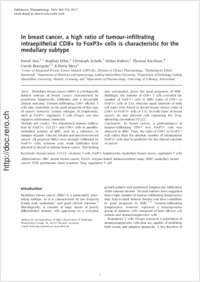In breast cancer, a high ratio of tumour-infiltrating intraepithelial CD8+ to FoxP3+ cells is characteristic for the medullary subtype
- Anz, David Centre of Integrated Protein Science Munich (CIPS-M), Division of Clinical Pharmacology, Munich, Germany - Medizinische Klinik Innenstadt, Munich, Germany
- Eiber, Stephan Centre of Integrated Protein Science Munich (CIPS-M), Division of Clinical Pharmacology, Munich, Germany
- Scholz, Christoph Department of Obstetrics and Gynaecology, Ludwig Maximilian University, Munich, Germany
- Endres, Stefan Centre of Integrated Protein Science Munich (CIPS-M), Division of Clinical Pharmacology, Munich, Germany
- Kirchner, Thomas Department of Pathology, Ludwig Maximilian University, Munich, Germany
- Bourquin, Carole Centre of Integrated Protein Science Munich (CIPS-M), Division of Clinical Pharmacology, Munich, Germany - Department of Pharmacology, University of Fribourg, Switzerland
- Mayr, Doris Department of Pathology, Ludwig Maximilian University, Munich, Germany
-
17.11.2011
Published in:
- Histopathology. - 2011, vol. 59, no. 5, p. 965–974
English
Aims: Medullary breast cancer (MBC) is a biologically distinct subtype of breast cancer characterized by prominent lymphocytic infiltrates and a favourable clinical outcome. Tumour-infiltrating CD8+ effector T cells may contribute to the good prognosis of this type of cancer; however, certain subtypes of lymphocyte, such as FoxP3+ regulatory T cells (Tregs), can also suppress antitumour immunity.Methods and results: We determined tumour infiltration by FoxP3+, CCL22+ and CD8+ cells in paraffin-embedded sections of MBC, and, as a reference, in samples of grade 3 ductal, lobular and mucinous breast cancer. All analysed MBCs were strongly infiltrated by FoxP3+ cells, whereas only weak infiltrates were detected in ductal or lobular breast cancer. This finding was unexpected, given the good prognosis of MBC. Strikingly, the number of CD8+ T cells exceeded the number of FoxP3+ cells in MBC (ratio of CD8+ to FoxP3+ cells of 2.6), whereas equal amounts of both cell types were found in ductal breast cancer (ratio of CD8+ to FoxP3+ cells of 1.1). In both types of breast cancer, we also detected cells expressing the Treg-attracting chemokine CCL22.Conclusions: In breast cancer, a predominance of tumour-infiltrating CD8+ over FoxP3+ cells was observed in MBC. Thus, the ratio of CD8+ to FoxP3+ cells rather than the absolute number of intratumoral FoxP3+ cells may be predictive for the clinical outcome of cancer.
- Faculty
- Faculté des sciences et de médecine
- Department
- Département de Médecine
- Language
-
- English
- Classification
- Biological sciences
- License
- License undefined
- Identifiers
-
- RERO DOC 28467
- DOI 10.1111/j.1365-2559.2011.04040.x
- Persistent URL
- https://folia.unifr.ch/unifr/documents/302450
Statistics
Document views: 79
File downloads:
- bou_bch.pdf: 159
